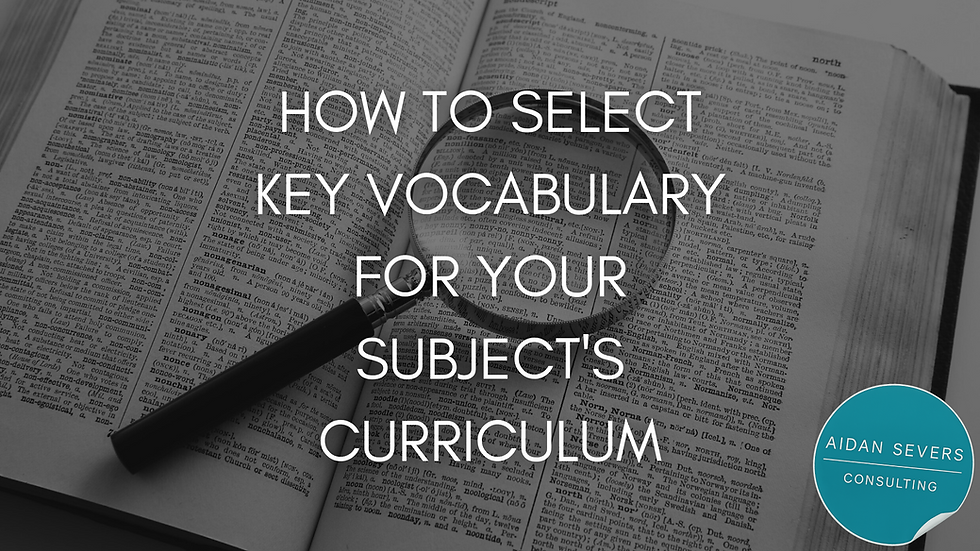Why We Should Prioritise The Teaching Of Tier 2 Words
- Aidan Severs

- Sep 30
- 3 min read

Isabel Beck, Margaret McKeown, and Linda Kucan’s work on vocabulary (see their book Bringing Words to Life) highlights Tier 2 words as high-utility academic vocabulary - words that are common across many contexts, but not as everyday as Tier 1 or so domain-specific as Tier 3.
In my last blog post 'How To Select Key Vocabulary For Your Subject's Curriculum', I mentioned that when selecting vocabulary for a curriculum "the temptation is to fill vocabulary lists with tier 3 words," however "our lists should... be weighted towards tier 2 words, ensuring that we are teaching the subject-specific meanings."
And it isn't just me who thinks this. The EEF's Improving Literacy in KS2 guidance document has this to say:
"Explicit teaching may best focus on Tier 2 words, words which can be considered as ambitious, and also those that children are likely to come across in a variety of contexts across the curriculum."
The point is that some Tier 2 words shift in meaning depending on the subject (or discipline), which can create challenges for learners.
Examples of Tier 2 Words
So, to illustrate this point further, here’s a list of such words, with explanations of how their meanings change in different subjects:
1. Volume
Science (Physics/Chemistry): The amount of space an object or substance occupies (e.g., measured in liters, cm³).
Mathematics (Geometry): The calculated three-dimensional measure of a solid (e.g., volume of a cube = side³).
Everyday/Language Arts: The loudness of sound OR a book in a series.
2. Table
Mathematics: A systematic arrangement of data in rows and columns.
Science: Reference tools like the Periodic Table of Elements.
Everyday/Language Arts: A piece of furniture.
3. Solution
Science (Chemistry): A mixture of substances where one dissolves in another (e.g., salt water).
Mathematics: The value(s) that satisfy an equation or inequality.
Everyday/Language Arts: An answer to a problem or challenge.
4. Scale
Mathematics: A ratio that shows the relationship between dimensions on a drawing and the actual size (e.g., 1 cm = 1 km on a map).
Science (Biology): Thin plates that form the covering of fish, reptiles, or skin (like dandruff “scales”).
Music: An ordered sequence of notes (e.g., C major scale).
Everyday Use: A device to measure weight.
5. Function
Mathematics: A relation where each input has exactly one output.
Science (Biology): The purpose or role of an organ/system (e.g., the function of the heart is to pump blood).
Everyday/Language Arts: A social gathering or event; or a general purpose of something.
6. Root
Science (Biology): The underground part of a plant that absorbs nutrients and anchors it.
Mathematics: A solution to an equation (e.g., square root of 9 = 3).
Language Arts (Etymology): The base part of a word that carries meaning (e.g., "tele" in "telephone").
7. Product
Mathematics: The result of multiplication (e.g., 6 × 7 = 42).
Economics/Business: An item or service created for sale.
Science (Chemistry): A substance formed as a result of a chemical reaction.
8. Factor
Mathematics: A number that divides evenly into another (e.g., 3 is a factor of 12).
Science (Biology): A gene or element that influences a trait (e.g., environmental factors).
Everyday/Language Arts: A circumstance or influence contributing to an outcome.
9. Mean
Mathematics/Statistics: The average of a set of numbers.
Everyday Language: Unkind or nasty behavior.
Language Arts: To signify or intend (e.g., “What do you mean by that?”).
10. Expression
Mathematics: A combination of numbers, symbols, and operations (e.g., 3x + 2).
Language Arts: A way of showing feelings through words, art, or behavior.
Science (Biology): The process by which information from a gene is used (gene expression).
The inclusion of the meanings from everyday language here is deliberate and important - these are the meanings that pupils are most likely to know and therefore are most likely to use to try to make sense of the word when they hear it in a new context.
Imagine talking about a 'table' in maths or science, or even just in a task which could be part of any subject (complete this table, for example), and a child assuming that you are referring to a piece of furniture!
Tier 2 words are a really important part of academic language, even at primary level - assuming children will learn all the correct meanings of these words without them being explicitly taught them is leaving a lot to chance. Best get them planned in so that you can ensure they are deliberately taught.
If you want to think more about selecting vocabulary to be taught in your curriculum, take a look at this blog post: 'How To Select Key Vocabulary For Your Subject's Curriculum'
And, if you're undertaking this piece of work for your subject's curriculum, or for your whole curriculum, reach out - I can support you.









.png)
.png)





